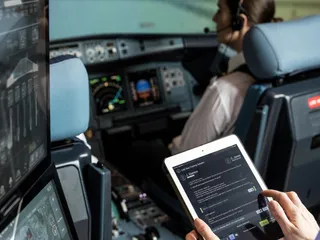ADDIE IT, AI, CBTA Integration
Contact Our Team
For more information about how Halldale can add value to your marketing and promotional campaigns or to discuss event exhibitor and sponsorship opportunities, contact our team to find out more
The Americas -
holly.foster@halldale.com
Rest of World -
jeremy@halldale.com

The aviation training landscape is undergoing a fundamental transformation as competency-based training and assessment (CBTA) redefines how pilots develop and maintain critical skills. In the context of this evolution there is also the integration of artificial intelligence (AI) and advanced information technologies with the traditional ADDIE (Analysis, Design, Development, Implementation, and Evaluation) instructional design framework. This convergence is set to upgrade pilot training by creating data-driven, personalised learning experiences that directly address operational realities.
As the industry moves beyond conventional training methodologies, the challenge is no longer simply about adopting new technologies, but rather about intelligently integrating operational data streams - including flight data monitoring (FDM), line operations safety audit (LOSA), and safety management systems (SMS) - into coherent training programs. This integration enables training organizations to bridge the gap between the learning environment and real-world operational performance, creating a feedback loop that enhances both safety and competency development.
The potential is significant, AI-powered systems can increasingly correlate simulator telemetry with instructor assessments, identify performance patterns across pilot demographics, and automatically generate targeted training scenarios based on operational risk data. However, realizing this potential requires navigating complex regulatory landscapes, substantial investment in technology infrastructure, and fundamental changes in how training organizations approach curriculum design and delivery.
Data Integration Strategies Across ADDIE Phases
Operational data such as from FDM, LOSA, and SMS are foundational to the analysis phase, according to Chris Ranganathan, CAE’s chief learning officer. “AI helps to derive learning objectives (LO) directly from regulatory requirements and operating manuals, ensuring that training design is grounded in operational reality,” he affirmed.
Systems like CAE Rise which integrate a threat and error management model, allow data insights to flow seamlessly into the Design phase, Ranganathan explained. “CAE Rise correlates simulator telemetry with instructor grading, minimizing duplication and ensuring fidelity across phases. In our work with one of our airline partners, LOSA data was segmented by pilot experience and mapped to CBTA competencies, allowing us to design targeted training areas of special emphasis (TASE) for specific demographics such as first officers with less than a particular number of hours on type,” he said.
AI Automates ADDIE Connections
The biggest opportunity is to connect the Analysis & Design phase to the Implementation and Evaluation phases, according to Yann Renier, head training and licensing at the International Air Transport Association (IATA). “These connections necessitate to use harmonized taxonomies (human performance taxonomy and safety taxonomy) in the training domain and in the operational domain,” he explained.
According to Ranganathan AI transforms the evaluation-to-analysis feedback loop into a true engine of continuous improvement. “Through platforms such as CAE Rise, real-time insights into pilot performance, instructor grading, and training effectiveness are captured and analysed. As experts note, AI makes it possible to close the loop-turning evaluation into actionable analysis that directly enhances training outcomes,” he said. “By detecting mismatches between instructor assessments and telemetry data, AI enables root cause analysis and drives curriculum refinement. Its potential lies in predictive modeling of future training needs, the dynamic adaptation of curricula to emerging performance trends, and the automated alignment of training scenarios with targeted behaviors and competencies. In this way, the feedback loop ensures that training remains agile, data-driven, and responsive to evolving operational demands.”
Personalized Learning and Enhanced Assessment
According to Renier, several tools have already been developed within the framework of evidence-based training (EBT) to collect human performance data. “This data analysis is already used in some form to tailor EBT training delivery. Nevertheless, currently and from a design perspective, the industry is already adapting the training to a pilot population but not at the individual level,” he said. “This step to personalize the competency development at the design level is very much ambitious taking into account the current state of the art. Regarding the competency assessment, the industry is currently in the process of identifying the human performance elements that could be collected by systems such as eye tracking, biometric sensors etc. with the idea to support the instructor observation of the trainees for improved objectivity and competency assessment accuracy.”
AI enables precision learning by adapting training to each pilot’s specific needs, according to Ranganathan. “Within the Design phase, it supports the mapping of pilot tasks, along with operational and environmental threats, to observable behaviors in the ICAO pilot competency framework - an essential step in developing a CBTA program,” he said. “In the Development phase, AI generates training scripts and assessment tools aligned with each LO. During the Implementation phase, AI supports ‘just-in-time’ testing and training, adapting content based on a pilot’s strengths, weaknesses, and even their operational exposure - routes, weather, and airport environments.”
CAE Rise helps improve objectivity in competency assessments, noted Ranganathan. “For example, in a real-world example with an operator analysing crew performance in the simulator for traffic alert and collision avoidance system (TCAS) events, instructor grading showed ‘below standard’ in only 2% of cases, while telemetry revealed exceedances in 20% of the cases – highlighting the need for standardized grading practices and the value of AI in validating assessments,” he added. “We have initiated a modernization of the courseware to capture learning metrics and generate data-driven insights that highlight opportunities for curriculum optimization. This journey leverages AI to address the complexity of such tasks given the volume of courses, linked to source materials, individual learning paths, and learning objectives.”
Implementation Challenges and Future Developments
According to Ranganathan, the most impactful AI developments will include real-time adaptive training systems that dynamically adjust scenarios during sessions and customize theoretical content based on informal learning patterns, cross-platform data harmonization enabling seamless integration across diverse data taxonomies, and AI-driven regulatory compliance engines that automatically align training programs with evolving standards. “The future of aviation training extends beyond technological advancement, it requires smarter integration strategies, strategic investment planning, and proactive regulatory alignment,” he told the author. “However, significant practical barriers remain. Financial constraints present the first challenge, as infrastructure and analytics platforms demand substantial capital investment. Technical challenges create additional complexity, particularly in achieving interoperability across ATOs, operators, and regulatory bodies. Finally, regulatory compliance requirements mean that data privacy protection and regulatory adherence must be embedded in every solution from the outset.”
Mapping that links pilot competencies and observable behaviors to specific flight phase tasks and safety taxonomy elements including threats, errors, and undesired aircraft states is necessary to design a consistent CBTA program, affirmed Renier. “As a consequence, in the next five years the next tool development will be to integrate the mapping data to ensure proper competency development during the CBTA program,” he said. “The first barrier has to do with the common understanding among states, regulators and industry stakeholders regarding the methodology and its implementation. Given the ongoing CBTA discussions within the ICAO Personnel Training and Licensing Panel (ICAO PTLP), there is a current risk that some states may publish inconsistent CBTA regulations due to the lack of practical implementation guides.”
Along with regulatory barriers comes the qualification of competent authority personnel in charge of the approval of the CBTA program, according to Renier. “This fundamental aspect will necessitate a significant effort from authorities to make sure personnel are able to conduct proper oversight of the organization delivering CBTA program,” he said. “Another barrier relates directly to the cost and time required for organizations to adequately train personnel responsible for the design-development and delivery of CBTA programs. The average duration for the initial qualification of CBTA instructor is two weeks and the recurrent instructor standardization takes an average of 1 or 2 days per year. Similar durations apply for the qualification of course developers.”
Summing Up
The integration of AI with CBTA represents more than a technological upgrade, it signals a paradigm shift toward data-driven, operationally grounded pilot training. Real-world implementations demonstrate that the marriage of the ADDIE methodology with operational data streams creates valuable opportunities for precision learning and objective assessment. The evidence is compelling, AI systems can identify performance discrepancies that human observation might miss, personalize training content based on individual pilot needs, and create dynamic feedback loops that continuously refine training effectiveness.
However, success in this transformation requires addressing fundamental challenges that extend beyond technology implementation. Regulatory harmonization across states and competent authorities remains critical to ensuring consistent CBTA standards worldwide. The substantial investment in infrastructure, personnel training, and system integration demands strategic planning and long-term commitment from training organizations. Most importantly, the industry must develop standardised taxonomies that enable seamless data exchange between operational and training domains.
Looking ahead, AI and IT integration should not be viewed as isolated technological solutions, but as components of a comprehensive strategy that aligns regulatory compliance, operational safety data, and individualized learning pathways. The future of aviation training lies in smarter integrations.
[Editor’s note: Mario Pierobon is a regular contributor to CAT. We enjoy receiving the European-based author’s valuable, in-depth insights on training and safety topics across the civil aviation industry.]


